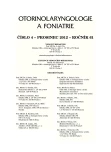Vašek’s Stuttering in the Opera „The Bartered Bride“ by Karel Sabina and Bedřich Smetana (A Phoniatric Analysis)
Authors:
K. Vrtička
Authors‘ workplace:
Kantonální nemocnice v Lucernu
; Univerzita ve Fribourgu (Švýcarsko)
; Karlova Univerzita v Praze
Published in:
Otorinolaryngol Foniatr, 61, 2012, No. 4, pp. 255-260.
Category:
Original Article
Overview
Vašek (Wenzel) in „The Bartered Bride“ („Prodaná nevěsta“) is the only main character in the world operatic literature who constantly stutters during his whole presence in seven scenes. „The Bartered Bride“ is a comic opera and Vašek’s childish simple-mindedness and his speech disorder are intended to make the audience laugh heartily. However, Sabina and Smetana never make the poor village guy Vašek the laughing-stock and have an indulgent comprehension for his impediment.
The Czech writer Karel Sabina (1813 - 1877) originally provided to the composer Bedřich Smetana (1824 - 1884) a superficial libretto for a comic operetta in one act. Sabina was highly successful in depicting the dual personality of the both ridiculous and pitiful stuttering village adolescent Vašek but expressed his disfluency simply by mechanical repeating of syllables. Smetana not only composed the wonderful music. He also gave the work its name „The Bartered Bride“, and gradually mastered the dramaturgy and the text into the definitive layout we have been enjoying till today. Quite specifically, he rephrased Vašek’s interrupted speech into a stuttering musical expression. The musicologists agree about the quite natural sounding of Vašek’s stuttered uttering. The medical literature has been so far focused on Smetana’s health disorders due to his syphilitic disease. Only some nameless „laryngologists“ were quoted maintaining that it is quite impossible to stutter in Vašek’s way. No systematic phoniatric analysis of his fluency disorder has been published.
The present study is assessing and enumerating Vašek’s tonic, clonic and tonoclonic speech blockades. It also delivers musical examples of his effective stuttered phrases and compares them to scientific descriptions and objective registrations of physical (external) and psychical (internal) symptoms of stuttering in phoniatric textbooks. It confirms the complete agreement of Smetana’s artistic expression of speech disfluency with the real stuttering.
Key words:
stuttering, physical and psychical symptoms of stuttering, stuttering in the opera, Vašek in „The Bartered Bride“, „The Bartered Bride“ by K. Sabina and B. Smetana.
Sources
1. Barančicová, S.: Prodaná nevěsta se zbavuje stoletého patosu. Lidové noviny, 4. 6. 1999.
2. Bartoš, F.: Karel Sabina: Prodaná nevěsta. Praha, Státní nakladatelství krásné literatury a umění, 1963.
3. Bartoš, F.: Vorwort/Foreword. Bedřich Smetana: Prodaná nevěsta. Adliswil, Kunzelmann, 1980.
4. Böhme, G.: Bedřich Smetana (1824 – 1884). In Medizinische Porträts berühmten Komponisten, Band 2. Stuttgart, G. Fischer, 1987.
5. Brod, M.: Die verkaufte Braut. München, Bechtle, 1962.
6. Eisner, P.: Předmluva k Ross, L.Q.: Pan Kaplan má třídu rád. Praha, Práce, 1972.
7. Gier, A.: Niescouplets und Lachensembles. Neue Zürcher Zeitung 94/1994.
8. Habermann, G.: Die Commedia dell’Arte und das Stottern auf der Bühne. Sprache-Stimme-Gehör, 19, 1955, s. 152-156.
9. Honolka, K.: Bedřich Smetana in Selbtzeugnissen und Dokumenten. Reibek, Rowohlt, 1978.
10. Imhof, G.: Die verkaufte Braut. Seminar für Filmwissenschaft der Universität Zürich, 1955.
11. Janáček, L.: Letnice 1910 v Praze. Literární dílo Leoše Janáčka. Brno, Editio Janáček, 2003.
12. Jiránek, J.: Smetanova operní tvorba I. Praha, Editio Supraphon, 1984.
13. Kalbeck, M.: Die verkaufte Braut. Leipzig, Peters, 1936.
14. Kiml, J.: Základy foniatrie. Praha, Avicenum, 1978.
15. Kühn, G. F.: Verschoben – Smetanas „Verkaufte Braut“’ in Berlin. Neue Zürcher Zeitung 21. 11. 2011, s. 40.
16. Large, B.: Smetana. London, Duckworth, 1970.
17. Lašťovka, M.: Poruchy plynulosti řeči. Praha, Scriptorium, 1999.
18. Luchsinger, R., Dubois, C.: Ein Vergleich der Sprachmelodie - und Lautstärkekurve bei Normalen, Gehirnskranken und Stotterern. Folia Phoniatrica, 15, 1963, s. 21-41.
19. Mareček, P.: Prodaná nevěsta podle Vladimíra Morávka. Dnes, 22. 5. 2004.
20. Nejedlý, Z.: Karel Sabina: Prodaná nevěsta. Praha, J. Otto, 1908.
21. Nejedlý, Z.: Friedrich Smetana. Praha, Orbis, 1924.
22. Nejedlý, Z.: Operní libreta Bedřich Smetany II. Prodaná nevěsta. Praha, Sbor pro postavení pomníku B. Smetanovi, 1930.
23. Neruda, J.: Bedřich Smetana. Národní listy 12, 8. 9. 1872, s. 1.
24. Pahlen, K.: Bedřich Smetana. Die verkaufte Braut. Mainz/München, Piper-Schott, 1983.
25. Sabina, K.: Wesničané. Praha, J. Pospíšil, 1847.
26. Sabina, K.: Věčný ženich. Praha, Rohlíček a Sievers, 1863.
27. Seeman, M.: Poruchy dětské řeči. Praha, Státní zdravotnické nakladatelství, 1955.
28. Schilling, A. V., Göler, D.: Zur Frage der Monotonie – Untersuchung beim Stottern. Folia Phoniatrica, 13, 1961, s. 202-218.
29. Srb, J.: Kterak Smetana komponoval. Dalibor, 24/4, 1902, s. 37.
30. Stefan, P.: Die verkaufte Braut. Wien, H. Reichner, 1937.
31. Stock, E.: Untersuchungen zur Intonation bei Stotterern. Folia Phoniatrica, 18, 1966, s. 447-461.
32. Stoffels, H.: Die verkaufte Braut. Berlin, R. Lienau, 1977.
33. Styriarte: Smetana: Die verkaufte Braut. Graz, Steierische Kulturveraustaltungen, 2011.
34. Teichmann, J.: Bedřich Smetana. Praha, Orbis, 1944.
35. Van Borsel, J., Geirnaert, E., Van Coster, R.: Another case of word-final disfluencies. Folia Phoniat. Logop., 57, 2005, s. 148-162.
36. Vlček, E. a spolupracovníci: Bedřich Smetana – fyzická osobnost a hluchota. Praha, Vesmír, 2001.
37. Vrtička, K.: Stottern auf der Operubühne. In Pahn J. et al. (ed.): Sprache und Musik. Stuttgart, F. Steiner, 2000.
38. Vrtička, K.: Voice changes during stuttering attacs. Proc. 25th IALP Congress, Montreal, 2001.
39. Vrtička, K.: Tinnitus in der Musik. ORL Praxis,7/2, 2007, s. 25.
40. Wagnerová, A., Šrámková, B.: Smetana, Dvořák, Janáček, Musikerbriefe. München, Deutsche Verlagsanstalt, 2003.
41. Weismann, W.: Zur Geschichte der „Verkauften Braut“. In Kalbeck, H.: Die Verkaufte Braut, Leipzig, Peters C. F., 1936.
42. Wiechmann, J., Richter, E.: Die Häufigkeit des Stotterns beim Singen. Folia Phoniatrica, 18, 1966, s. 435-446.
Labels
Audiology Paediatric ENT ENT (Otorhinolaryngology)Article was published in
Otorhinolaryngology and Phoniatrics

2012 Issue 4
Most read in this issue
- Bardet-Biedl Syndrome
- Complex Care of Patient after Surgery on Vestibular Schwannoma
- Twenty Years Since the Foundation of Daily Rehabilitation Stationary Ward at Department of Phoniatrics First Faculty of Medicine Charles University in Prague and General University Hospital in Prague
- Education of Esophageal Voice
